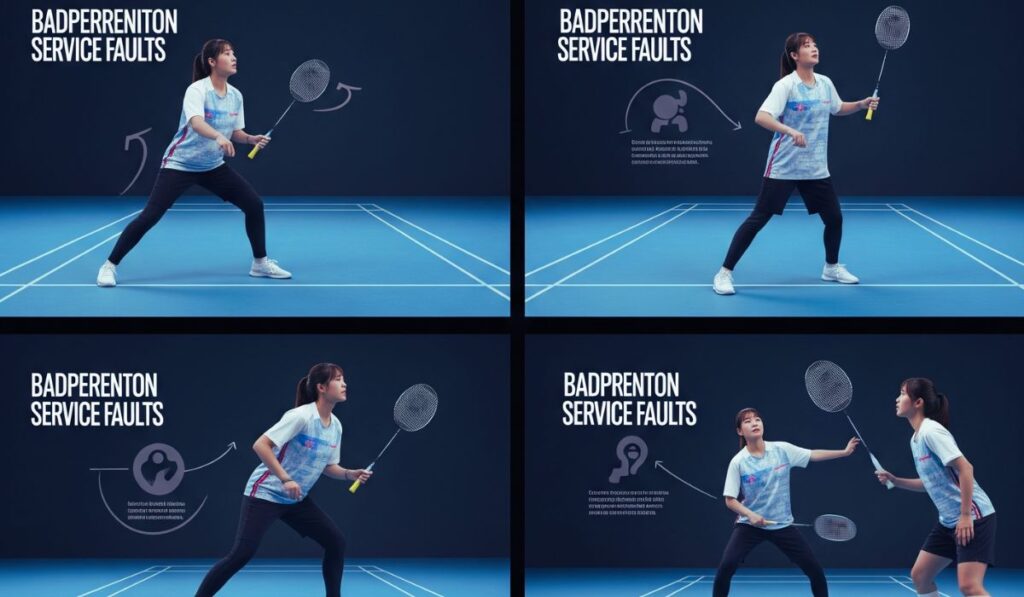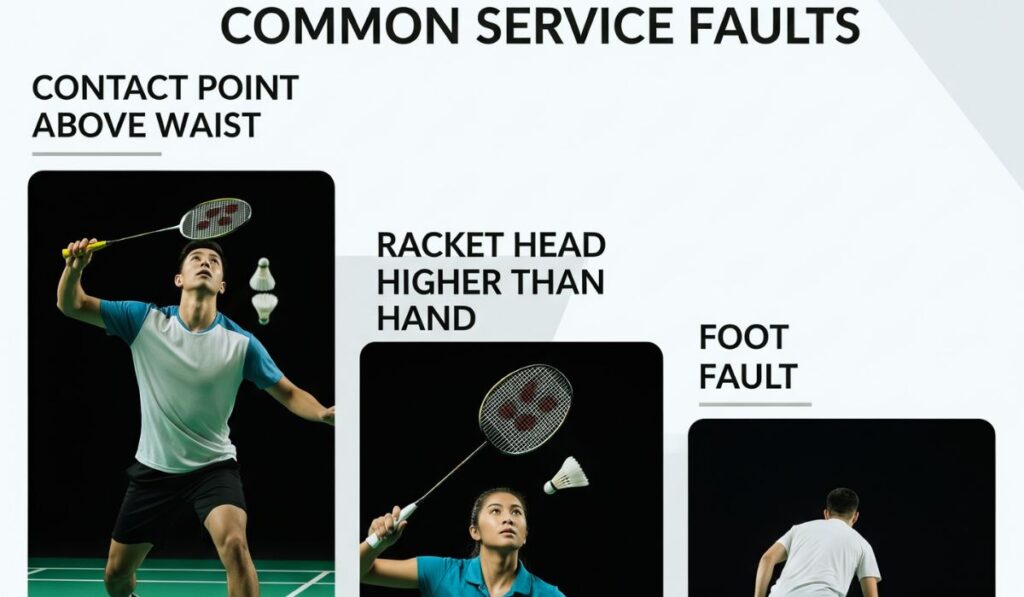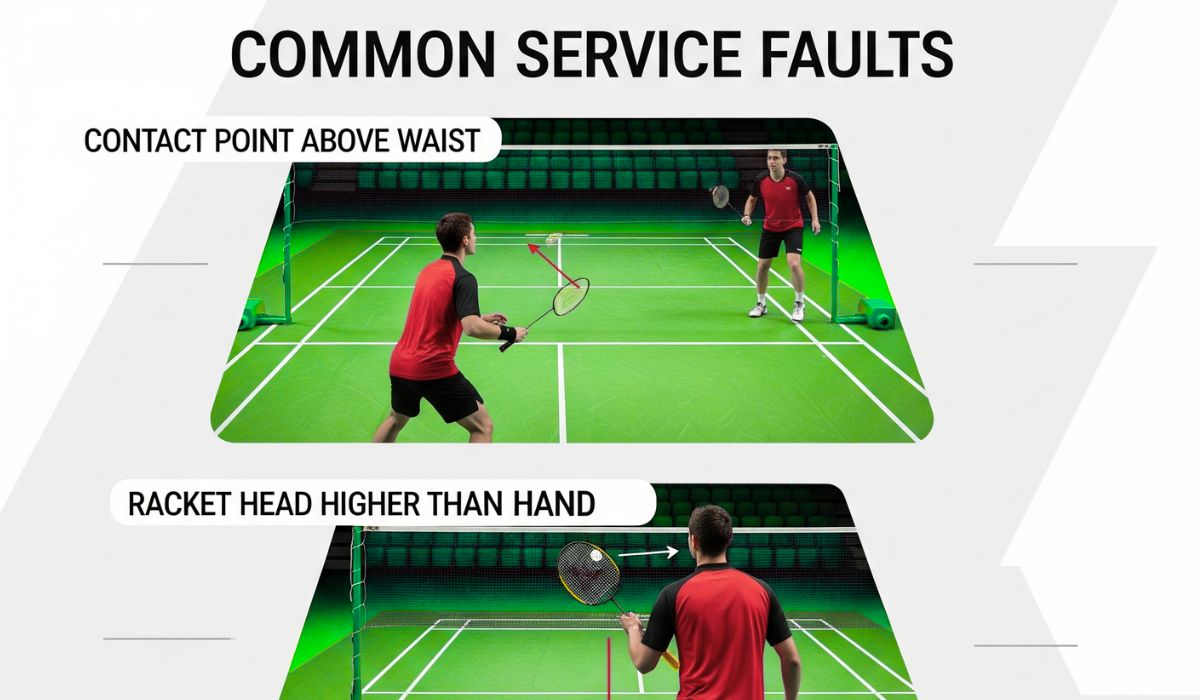You Won’t Believe How These Common Service Faults Could Be Ruining Your Game—or Supercharging Your Wins
Few things in badminton feel more deflating than being called for a service fault just when your rhythm flows. Yet understanding those precise mistakes can be empowering. In this article I walk you through the official causes of service fault, why each rule matters, and how mastering them brings power and confidence to your serve.
What Are Service Faults?
A service fault happens the moment your serve breaks any rule. Umpires or service judges spot these infractions. In club play without dedicated judging, being faulted often sparks disputes. Learning those faults gives you clarity and control.
Serve Height: The Most Common Error
Perhaps the most frequent misstep is hitting the shuttle above the allowed height. BWF rules require that the entire shuttle be below 1.15 metres at the moment of impact. That invisible line at the waist—just under the bottom rib—can feel like a barrier. Breaking it makes your serve illegal and costs you a point.
Racket Angle Faults
Another subtle but dramatic error comes when the racket head points upward at impact. The shuttle must be struck with the racket angled downward. If you flick or slice and the head faces up, even by degrees, that counts as a fault.
Foot Faults and Position
Your feet must stay stationary throughout the serve. Both feet must touch the court and not touch any boundary line. Stepping on the line or raising a foot early is a fault, and it tends to happen when tension ramps up in critical moments.

Delayed or Two‑Stage Motion
A serve must be delivered in one smooth, forward motion. Any pause between backswing and forward swing, or a stop‑start tap behind the shuttle, is illegal. That break disrupts fluidity and risks diagnosis as a service fault.
Serving from Wrong Court or Out of Turn
Serving from the wrong side of the court or out of turn is also a service fault. If you serve from the left court when you should be on the right, or swap turns in doubles incorrectly, the point is awarded to your opponent.
Missing the Shuttle
If you swing and miss the shuttle completely, that is an immediate fault. There is no second serve in badminton. Even an unintended miss costs you the serve and the rally.
Why These Rules Exist
The purpose behind these rules is fairness and consistency. Serve height, shuttle angle, foot position, and motion combine to limit advantage gained from deceptive or overly aggressive serves. Legendary players have struggled with inconsistent judgments, especially without objective tools like service judge panels or fixed‑height markers.
Real World Complaints and Controversies
Even elite players have protested inconsistent fault calls. For instance, Kidambi Srikanth described umpiring decisions as “ridiculous” when service faults shifted between games. That unreliability can haunt confidence and create emotional frustration mid‑match.
Practice to Avoid Faults
Success comes from disciplined serve practice. In Reddit discussions, advanced players report fault rates averaging one to three per set. They practice against a string at net height, repeat legal serves slowly, and monitor foot position carefully.
Building Confident Rhythm
Vision your serve: stationary feet, racket angled cleanly downward, shuttle whispering under the waist, motion smooth like water. This sensory rhythm avoids faults and builds emotional trust in your serve.
The Triumph of Legal Serving
When you serve clean legally, when you avoid every service fault, your serve becomes a weapon. Short flicks land sharp and low. Drives keep the receiver guessing. You step into every rally with confidence. That power feels incredible.
The Sting of a Bad Call
Being faulted on your serve when you felt confident can feel crushing. That negative moment shakes your rhythm, disrupts your mental game, and leaves you frustrated. But understanding exactly why that fault happened can flip the experience into a learning opportunity.
Why Service Faults Exist
Service faults are enforced to keep the game fair and consistent. Rules about serve height, racket angle, foot placement, and motion eliminate deceptive advantages and ensure every rally starts on an equal footing.
Serve Height: The Invisible Barrier
The most frequent source of fault is serve height. BWF rules require that the shuttle be struck below waist height—about 1.15 metres. If it rises above that, even momentarily, the serve is illegal. That invisible line can feel like a limit on power—but respecting it gives you control.
Racket Angle: A Subtle Mistake
The racket head must be angled downward at the moment of impact. An upward tilt—even slight—violates the rule. That small misalignment may feel natural in a quick wrist flick, but it costs a point and breaks rhythm.
Foot Faults: Anchoring with Discipline
Your feet must stay flat and fixed on the court without touching boundary lines. It may feel minor to lift a heel or shift in tension—but doing so during service becomes a fault. Staying grounded requires mental focus as well as physical discipline.
Motion Faults: Flow or Pause
A service motion must be smooth and continuous. A two‑stage swing or hesitation behind the shuttle triggers a fault. You must move forward in a single motion. That fluid delivery feels elegant—but demands rehearsal.
Serving on the Right Court
Serving from the correct side and in the right order is mandatory. If you serve from the wrong court or out of turn in doubles, it becomes a service fault. That glaring mistake often arises from nerves under pressure.
Missed Serves: No Second Chances
Swinging and missing the shuttle altogether counts as a fault. You lose the serve instantly. Even a flick that doesn’t connect costs you the rally. Accepting that finality sharpens your focus.
Emotional Impact of Repeated Faults
Multiple service faults can erode confidence quickly. Badminton Service Faults That negative spiral leads to hesitation, doubt, and timid serves. Recognizing this downward emotional curve can help you reset mentally.
Empowerment Through Practice
When you train deliberately on Badminton Service Faults rules, every part of the motion becomes purposeful. You feel more grounded, more confident in your technique. That empowerment transforms serve from a risk into a weapon.
Sensory Awareness in Serving
Feel the cool grip of your racket. Sense the plunge of your foot pressing down. Hear the soft snap of the shuttle leaving the strings. A mindful, sensory serve is smooth, precise, and resistant to Badminton Service Faults.
Real Player Frustrations
Pro players occasionally voice frustration at inconsistent umpiring of service faults. Kidambi Srikanth once described umpiring calls as “ridiculous”, arguing that varying judgements disrupted his game. Those doubts affect even the top echelons.
Use Tools to Train Serve Consistency
Many players use physical markers like a string at waist height to test serve legality. Others rehearse in front of a mirror or use a coach’s feedback. These tools convert ambiguity into measurable feedback and build trust in your delivery.
Counting Your Faults
Advanced players often track their badminton service faults rate—some report one to three faults per set. Monitoring that rate helps identify weak points, whether in foot stability, timing, or racket preparation.
The Winning Consequence
When you consistently serve without badminton service faults, you gain psychological and tactical advantage. Short flick serves land low and sharp. Drives keep opponents guessing. You begin play feeling sharp, deliberate, and dominant.
Practice Routines That Work
A few drill routines stand out: serve against a height string, alternate feet posture checks, practice downward racket angle with feedback from a coach. Repeating these drills until they feel reflexive reduces service fault risk dramatically.
Mental Reset After a Fault
When a badminton service faults is called, pause. Breathe. Visualize your next serve executed with perfect foot positioning, aligned racket head, smooth motion. That mental reset shifts your response from frustration to focus.
Confidence From Physical Preparation
Walking to the badminton service faults line knowing your foot positioning is sound and your racket angle is disciplined brings calm. That tangible preparation translates to emotional confidence during serve delivery.
Triumph in Legally Perfect Serves
When you serve clean and legal, your shot feels fluid. The shuttle floats precisely, your opponent reacts on delay, and your own mind registers mastery. That positive sensation builds momentum for the rest of the match.
A Small Mistake That Costs Everything
In badminton, the serve may seem simple, but it’s where the match can be won—or lost. One small mistake can lead to a service fault, costing you the rally before it even begins. It’s frustrating, yes—but also incredibly fixable.
What Are Badminton Service Faults?
badminton service faults happen when the server violates one of several very specific rules during the serve. These rules cover shuttle position, footwork, racket motion, and more. Every fault gives a point to your opponent, so the consequences are real.
Why You Must Master the Serve
badminton service faults The serve sets the tone for every rally. If it’s weak or illegal, you start every point at a disadvantage. But when it’s strong, smooth, and legal, you control the game right from the start.
The Most Common Service Fault: Shuttle Height
One of the most misunderstood badminton service faults relates to the height of the shuttle. It must be struck below 1.15 meters—roughly at your bottom rib. Go even a little higher, and you’re faulted.
Racket Position: A Hidden Trap
The racket head must be pointing downwards when it makes contact with the shuttle. If it’s angled upwards, even slightly, that’s a badminton service faults. It’s a subtle but costly mistake.
Two-Stage Motion: The Flow Must Be Smooth
badminton service faults Serving must be one continuous, forward motion. Pausing mid-serve or having a jerky, two-step action is illegal. The beauty of a legal serve is in its rhythm.
Footwork: More Than Just Standing Still
Both feet must be on the ground and stationary before and during the serve. Lifting your heel, stepping sideways, or even slightly shifting weight before contact can all result in a foot badminton service faults.
Serving From the Wrong Side
In both singles and doubles, serving from the incorrect badminton service faults box is a violation. This usually happens when players lose track of the score. It’s basic—but easy to overlook.
Serving Out of Turn in Doubles
This mistake happens more often than people admit. Doubles serving has a specific rotation, and if you serve when it’s your partner’s turn, it’s considered a fault—even if the serve is perfect.
Flick Serves: Legal but Risky
Flick serves are powerful when done legally, but many players push the limits and get faulted for too high a shuttle or upward racket angle. Mastering the flick requires absolute precision.
Emotional Toll of Repeated Faults
Nothing breaks focus like being faulted again and again. It creates doubt, tension, and even embarrassment. The mental side of badminton service faults is real—and it can ruin your momentum if you let it.
Learning Through Frustration
But there’s something powerful about failure. Each badminton service faults is a signal. A lesson. Players who take the time to truly understand why a fault happened improve faster and with more confidence.
Service Judges and Pressure
In pro matches, badminton service faults judges are laser-focused on every serve. The pressure of knowing you’re being watched intensifies the risk of faulting. But the best players learn to thrive under that pressure.
False Confidence in Casual Play
Many players never face badminton service faults in friendly games. So when they enter tournaments or competitive leagues, they’re shocked to be called out. Practicing legal serves is essential even in casual sessions.
Using Drills to Build Legal Technique
One simple drill is to tie a string across the court at 1.15 meters and practice serving under it. You’ll quickly feel the right height. Practicing with video feedback also helps correct bad habits.
Muscle Memory and Mental Clarity
Legal serving should feel automatic. When your foot position, racket angle, and serve height become muscle memory, your confidence skyrockets. You focus less on the serve and more on your strategy.
Importance of the White Tape
The top of the net is marked by a white band. Seeing your serve skim just under that tape is a thrilling feeling. It’s also a sign your serve is clean and competitive.
Mastering the Art of Deception—Legally
You can still be deceptive while keeping it legal. A well-timed short serve or a quick flick can surprise opponents. The trick is to learn how to stay within the rules while playing creatively.
Practicing With Intent
Blind repetition won’t fix badminton service faults. You must serve with awareness—checking your stance, motion, and contact point. Ten minutes of focused serving is better than an hour of lazy reps.
Watching the Pros
Study how professional players serve. Notice their foot stability, their calm preparation, and the flawless flow of their motion. Emulating that calm discipline can work wonders for your own game.
Service Faults in Youth Tournaments
Young players often struggle with badminton service faults rules. Coaches should make legal serving a priority early on. Bad habits formed young are hard to break later.
How Faults Impact Scoring
One fault might feel small, but in a close match, a single service error could shift the momentum entirely. Players often lose games by just two points—don’t let an avoidable fault be the reason.
Pressure Moments and Fault Risks
Tense moments—match point, long rallies—are when players most often badminton service faults. Your nerves affect motion. Practicing under pressure builds resilience and prepares you for real match scenarios.
Building a Routine That Grounds You
Have a serve routine—something consistent that centers you. A breath, a bounce, a glance. This routine gives you control and focus, making it harder for tension to cause a fault.
Turning Faults Into Mastery
Every player badminton service faults. Even champions. What separates great players is how they respond. Learn from every mistake, refine your technique, and own your serve. The serve becomes your edge—not your weakness.
The Role of Muscle Tension in Faults
One overlooked cause of Badminton Service Faults is muscle tension. When you’re nervous, your hands tighten, your grip stiffens, and your wrist motion becomes jerky. That tension leads to inconsistent racket angles and rushed serves. Learning to stay physically relaxed under pressure reduces unintentional faults significantly.

Court Conditions Can Also Mislead
Slippery shoes, uneven surfaces, or unfamiliar lighting can affect your foot stability or depth perception. Players sometimes lift a foot slightly without noticing—or misjudge the height of the shuttle due to glare. Being aware of your environment helps you adjust and avoid unnecessary service errors.
Badminton Service Faults and Doubles Strategy
In doubles, where teamwork and rotation are key, Badminton Service Faults affect more than just the server. They shift momentum for the entire pair. Doubles players must communicate clearly before every point, know whose turn it is, and ensure legal foot positioning on both sides of the court.
Adapting Your Serve to Opponent Pressure
When facing a skilled receiver, it’s tempting to rush your serve or flick harder to surprise them. But pressure can lead you to overcompensate—lifting the shuttle too high, or slicing too sharply. The key is not to react emotionally, but to refine your technique and stay disciplined.
Why Some Players Get Away With It
In casual or local matches without strict officiating, players sometimes get away with illegal serves for years. But once they enter competitive play with umpires or service judges, they’re quickly Badminton Service Faults. It’s not unfair—it’s a wake-up call to improve. Playing by the rules is what prepares you for real progress.
Video Replay: Your Honest Coach
One of the best ways to fix repeated Badminton Service Faults is to record yourself. You’ll see things you never notice in the moment—subtle pauses, raised heels, or illegal contact points. Watching your own motion in slow-motion brings a kind of honesty that fast-paced gameplay doesn’t offer.
Faults at the Net: When to Challenge
In elite matches, some service faults are debatable—especially when judged visually at net height. If you believe a call was incorrect, you have the right to question it respectfully. But rather than argue, focus your energy on learning from it and adjusting your next serve.
Developing a Strong Backhand Serve
The backhand serve is common in modern badminton, especially in doubles. But mastering it legally requires precision. The shuttle must still be below waist height and the racket angled correctly. Many players unintentionally fault with wrist flicks that raise the contact point too high.
Keeping Fault Count Low in High-Stakes Games
In tournaments, the difference between a win and a loss could be just two or three points. One illegal serve could hand that edge to your opponent. Players who win consistently are not just better hitters—they’re more consistent and rarely fault in pressure moments.
Mastery Is a Journey
There’s no shortcut to mastering legal, effective serving. It takes discipline, feedback, repetition, and a willingness to correct yourself. But once you stop fearing Badminton Service Faults and start owning your technique, the serve becomes one of your most valuable tools on court. It’s no longer a risk—it’s a weapon.
Final Thoughts: From Faults to Mastery
Service faults don’t just disrupt a point—they shake focus and flow. But by mastering serve height, foot stability, racket angle, and continuous motion, you convert each rule into a tool. Your serve becomes reliable, legal, and strategically potent. Understanding badminton service faults deeply gives you control, clarity, and consistent success.


2 thoughts on “Frustration and Triumph: Unmasking the Fierce Reality of Badminton Service Faults”